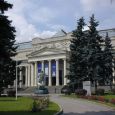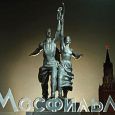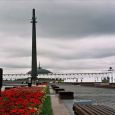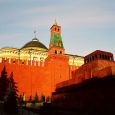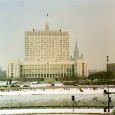Moscow
Advertisement
Air
There are five primary commercial airports serving Moscow: Sheremetyevo International Airport, Domodedovo International Airport, Bykovo Airport, Ostafyevo International Airport and Vnukovo International Airport. Sheremetyevo International Airport is the most common entry point for foreign passengers, handling sixty percent of all international flights. Domodedovo International Airport is the leading airport in Russia in terms of passenger throughput, and is the primary gateway to long-haul domestic and CIS destinations and its international traffic rivals Sheremetyevo's. The three other airports particularly offer flights within Russia and to and from states from the former Soviet Union.Moscow's airports vary in distances from MKAD beltway: Bykovo is the farthest, at 35 kilometres (21 mi); Domodedovo is next at 22 kilometres (13.7 mi); Vnukovo is 11 kilometres (6.8 mi); Sheremetyevo is 10 kilometres (6.25 mi); and Ostafievo, the nearest, is about 8 kilometers (5 mi) from MKAD.
There are also several smaller airports near Moscow, such as Myachkovo Airport, intended for private aircraft, helicopters and charters.
Water
North River Terminal Moscow also has two passenger terminals, (South River Terminal and North River Terminal or Rechnoy vokzal), on the river and regular ship routes and cruises along Moskva and Oka rivers, which are used mostly for entertainment. The North River Terminal, built in 1937, is also the main hub for long-range river routes. There are also three freight ports serving Moscow.
Railway
Moscow employs several train stations to serve the city. Moscow's nine rail terminals
They are located close to the city center, but each handles trains from different parts of Europe and Asia.[113] There are also many smaller railway stations in Moscow. As train tickets are relatively cheap, they are the mode of preference for travelling Russians, especially when departing to Saint Petersburg, Russia's second-largest city. Moscow is also the western terminus of the Trans-Siberian Railway, which traverses nearly 9,300 kilometres (5,800 mi) of Russian territory to Vladivostok on the Pacific coast.
Suburbs and satellite cities are also connected by commuter elektrichka (electric rail) network. Elektrichkas depart from each of these terminals to the nearby (up to 140 kilometres (87 mi)) large railway stations.
Roads
There are over 2.6 million cars in the city on a daily basis. Recent years have seen the growth in the number of cars, which have caused traffic jams and the lack of parking space to become major problems.
The MKAD, along with the Third Transport Ring and the future Fourth Transport Ring, is one of only three freeways that run within Moscow city limits. However, as one can easily observe from a map of Moscow area, there are several other roadway systems that form concentric circles around the city.
The Pushkin Museum
The Pushkin Museum of Fine Arts is the largest museum of European art in Moscow, located in Volkhonka street, just opposite the Cathedral of Christ the Saviour.
The museum's name is misleading, as it has nothing to do with the famous Russian poet. It was founded by professor Ivan Tsvetaev (father of the poet Marina Tsvetaeva). Tsvetaev persuaded the millionaire and philanthropist Yuriy Nechaev-Maltsov and the fashionable architect Roman Klein of the urgent need to give Moscow a fine arts museum.
Mosfilm
Mosfilm is a film studio, which is often described as the largest and oldest in Russia and in Europe. Its output includes most of the more widely-acclaimed Soviet films, ranging from works by Tarkovsky and Eisenstein (commonly considered the greatest Soviet directors), to Red Westerns, to the Akira Kurosawa co-production and the epic Война и Мир / War and Peace.
Worker and Kolkhoz Woman
Worker and Kolkhoz Woman is a 24.5 meter (78 feet) high sculpture made from stainless steel by Vera Mukhina for the 1937 World's Fair in Paris, and subsequently moved to Moscow. The sculpture is an example of the socialist realistic style, as well as Art Deco style. The worker holds aloft a hammer and the kolkhoz woman a sickle to form the hammer and sickle symbol.
Poklonnaya Hill
Poklonnaya Gora metaphorically "Worshipful Submission Hill"') is, at 171.5 metres, one of the highest spots in Moscow. Its two summits used to be separated by the Setun River, until one of the summits was razed in 1987. Since 1936, the area has been part of Moscow and now contains the Victory Park with many tanks and other vehicles used in the Second World War on display.
Historically, the hill had great strategic importance, as it commanded the best view of the Russian capital. Its name is derived from the Russian for "to bow down", as everyone approaching the capital from the west was expected to do homage here. In 1812, it was the spot where Napoleon in vain expected the keys to the Kremlin to be brought to him by Russians.
Gorky Central Park
Gorky Central Park of Culture and Leisure is an amusement park in Moscow, named after Maxim Gorky.
Gorky Park was opened in 1928 and is located at Krymsky Val and situated just across the Moskva River from Park Kultury Metro Station. The Park was planned by Konstantin Melnikov, a world-famous soviet avant-garde and constructivist architect. Gorky Park was created by the amalgamation of the extensive gardens of the old Golitsyn Hospital and the Neskuchny Palace and covers an area of 300 acres (120 ha) along the river.
The White House
The White House , also known as the Russian White House, is a government building in Moscow. It was designed by the architects Dmitry Chechulin and P. Shteller. Construction started in 1965 and ended in 1981. Overall design follows Chechulin's 1934 draft of the Aeroflot building.
The White House was pictured on a 50 kopeck stamp in 1991, honoring the resistance to the failed coup attempt of 1991.
The building stood damaged for some time after the 1993 crisis, and the black burns became famous, so much so that it became tradition for newlyweds to be photographed in front of its damaged facade. It was shown in the seventh Police Academy movie, "Mission to Moscow".
The reformed parliament, known thereafter by its Tsarist era title of Duma, was elected in 1994 and moved to another building on Moscow's Okhotny Ryad.
The renovated White House now houses the Russian government. An inscription at the base of the tower reads, "House of the Government of the Russian Federation."
Information not available


